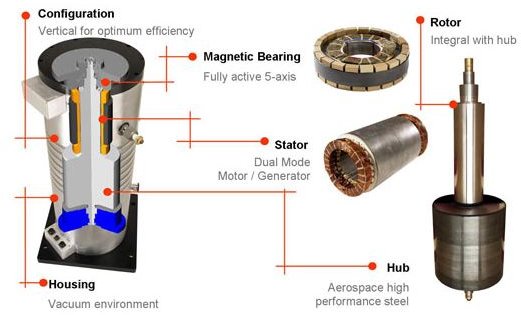Flywheel Energy Storage: How Energy is Stored using Flywheels
Energy Storage Using Flywheels
What is Flywheel Energy Storage?
Flywheel Energy Storage is a technique in which energy in the system is stored for future use, just as batteries are used to store energy for future use today.
In batteries, initially energy is stored by other electrical energy sources or energy is stored from a result of some chemical reaction.
Flywheel energy storage can be compared to the battery in the same way. The flywheel energy storage system uses electrical energy and stores it in the form of kinetic energy. When energy is required from the flywheel energy storage system, the kinetic energy in the system is transformed into electric energy and is provided as output_._
Energy Storage Using Flywheels
How it Works:
Electrical energy or mechanical energy is used to spin the flywheel at great speeds and to store energy. The greater the rotational speed of the flywheel, the greater the amount of charge stored in it. Thus the energy is stored and it can be retrieved at a later point of time. The flywheel keeps spinning at a particular speed as long as energy is not retrieved from it. The speed at which the flywheel rotates is reduced when energy is retrieved from it. The flywheel stops spinning once all the energy is drained from the system.
Image Credits: https://www.activepower.com/fileadmin/images/flywheel.jpg
The parts of a Flywheel Energy Storage System:
- Rotor - Initially it was made of a steel flywheel. Recent advancements has seen the use of carbon fiber composite rotors that are lighter and have higher tensile strength than their predecessors, the steel flywheels. The heavier and the greater the diameter of the rotor, the more the energy that can be stored in the rotor.
2. Bearings - The flywheel rotates on mechanical bearings. Lately magnetic bearings are used that are more efficient and further reduce energy lost due to friction. High temperature semi-conductors are used in the making of the magnetic bearings.
The rotor and bearings assembly is kept in a vacuumised environment to further reduce the friction.

Image Credit: https://thefraserdomain.typepad.com/photos/uncategorized/vycon_schematic.jpg
Applications:
Road, Rail, Motorsports - The flywheel energy storage technology has been used to accelerate vehicles very efficiently and it causes less pollution, too.
Uninterrupted Power Supply - An uninterrupted power supply can be maintained as flywheels energy storage systems have faster discharge rates and it doesn’t experience the load, unlike battery storage systems.
The Future of Flywheel Energy Storage:
Energy stored in flywheels is known to provide 90% efficiency, unlike other storage systems, and they have faster discharge rates_,_ too. Moreover their energy loss is little, meaning if the same energy is stored in a battery or a flywheel and after a particular period of time, the energy lost, without retrieving energy in the battery will be more than the energy lost in by the flywheel energy storage. Many qualities make the flywheel energy storage system a potential candidate for the power storage system of the future.
Some Disadvantages of Flywheel Energy Storage
Flywheels also have some difficulties and disadvantages, such as the flywheel moving off it’s axis if the rotor spins too fast. Taken to an extreme, an uncontrolled flywheel might move away from it’s axis and smash at the walls of the container- and may break into pieces making it dangerous for people around it. So care should be taken on the input energy given and it should be housed in a proper place so that it doesn’t cause harm, no matter what happens.
However there are ways in making the flywheel energy storage system safer and using it to its full potential and thereby tapping its efficiency for better ways of storing energy.
